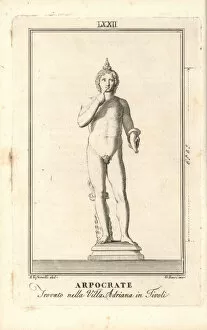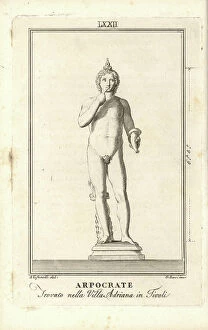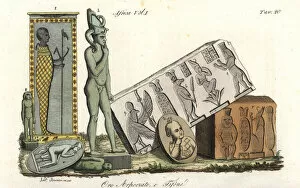Harpocrates Collection
"Harpocrates: The Silent Guardian of Ancient Mythology" Step into the world of ancient mythology and discover the enigmatic figure known as Harpocrates
All Professionally Made to Order for Quick Shipping
"Harpocrates: The Silent Guardian of Ancient Mythology" Step into the world of ancient mythology and discover the enigmatic figure known as Harpocrates, the Greek god of silence. This captivating statue depicts a young deity with his finger pressed against his lips, symbolizing secrecy and discretion. Intriguingly, Harpocrates often appeared alongside other prominent gods such as Plutus and Fortuna. Together, they represented wealth, luck, and silence—a powerful combination that held great significance in ancient Greek culture. The influence extended beyond Greece; he also found a place in Roman mythology. Engravings depicting Roman Isis and Horus show their connection to Harpocrates, emphasizing his role as a child god associated with protection and rebirth. Travel back even further to ancient Egypt, where statues from the Late Period-Ptolemaic Period showcase statuettes of both Harpocrates himself and Horus portrayed as a child—known as Harpokrates. These artifacts highlight the enduring fascination with this youthful deity throughout different civilizations. Delve deeper into Egyptian artistry through an intricately engraved mirror featuring the figure of Harpocrates. This stunning piece demonstrates how he was revered not only for his divine attributes but also for his aesthetic appeal. Egyptian gods like Horus, Typhon, and Nut were often depicted alongside Harpocrates in various artworks—an indication of their interconnected roles within Egyptian mythology. Their collective presence showcased harmony between deities responsible for different aspects of life. One particularly striking lithograph showcases the goddess Isis nurturing her infant son Horus—a poignant representation that echoes similarities between these figures' stories and those surrounding Harpocrates' birth. Even outside mythological contexts, artists have been captivated by this intriguing deity throughout history. Jan Muller's painting "Harpocrates Philosopher" immortalizes him as a symbol representing wisdom derived from silent contemplation—a testament to his enduring influence.

























